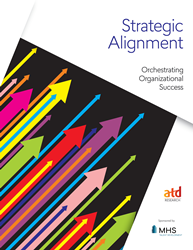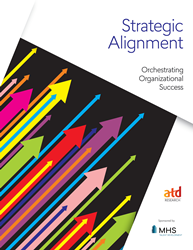
“It’s important to scale back strategically, if necessary, without getting cut off entirely. This helps the organization avoid losing its momentum with developing talent and staying prepared to meet its future needs.” — Holly Bowers, director of training and development at Willmeng Construction.
ALEXANDRIA, Va. (PRWEB)
June 09, 2020
Talent development functions have room to improve their strategic alignment to business goals, according to a new report by the Association for Talent Development.
Strategic Alignment: Orchestrating Organizational Success, sponsored by MHS Talent Development, shows that only 42 percent of respondents indicated their organization’s talent development and business strategies were aligned to a high or very high extent.
Strategic alignment “starts with defining what counts,” Kimberly Currier, senior director for talent development for Americas at AECOM, said in the report. “We focus on knowing what business strategies are priorities for the year and, from there, understanding what the business needs its people to do to carry out those strategies.”
The head of human resources is most frequently involved in determining talent development strategy, according to 72 percent of the report’s respondents. Next are business unit leaders (60 percent), followed by the head of talent development (57 percent). Thirty-nine percent of organizations involve the chief executive officer in creating the talent development strategy.
Some other key takeaways from the report include:
-
Fifty-six percent of organizations report on talent development’s performance to their boards of directors, and 78 percent do so during meetings of their senior leader or executive teams. - Some best practices associated with having high levels of alignment between business and talent development include having talent development programs that reflect official organizational values, using a centralized reporting structure for talent development, having business leaders that vocalize their support for talent development, and enabling talent development leaders to influence business strategy.
Some of the strategic goals of the organization and talent development have been scaled back during the COVID-19 pandemic, but Holly Bowers, director of training and development at Willmeng Construction, noted in the report that doing away with goals or strategies that surround those goals can be detrimental to the organization.
During difficult times for an organization, “It’s important to scale back strategically, if necessary, without getting cut off entirely,” Bowers explained in the report. “This helps the organization avoid losing its momentum with developing talent and staying prepared to meet its future needs. Otherwise, you start over from square one.”
About ATD
The Association for Talent Development (ATD) is the world’s largest professional membership organization supporting those who develop the knowledge and skills of employees, improve performance, and help to achieve results for the organizations they serve. Established in 1943, the association was previously known as the American Society for Training & Development (ASTD).
ATD’s members come from more than 120 countries and work in public and private organizations in every industry sector. ATD supports talent development professionals who gather locally in volunteer-led U.S. chapters and international member networks and with international strategic partners.
For more information, visit td.org.
Share article on social media or email:

